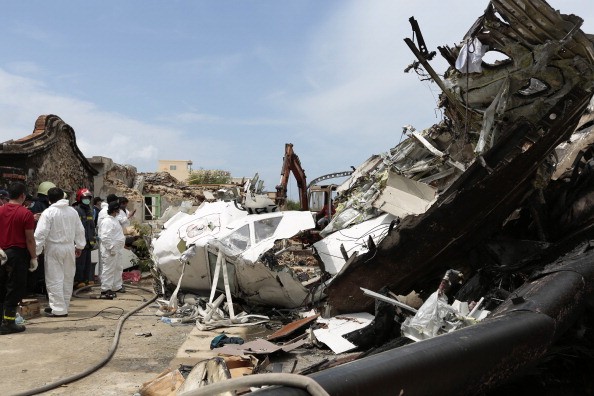ASC's Latest Report Sheds Light on What Caused TransAsia Plane Crash
| Mia Ren | | Jan 30, 2016 10:58 AM EST |
(Photo : Photo by Ashley Pon/Getty Images) Criminal Investigation Bureau search through the crash site where TransAsia Airways flight GE222 crashed the night before near the airport at Magong on July 24, 2014 in Penghu Island, Taiwan.
Taiwan's Aviation Safety Council (ASC) released a detailed report on Friday about the TransAsia flight that crashed on July 2014.
The TransAsia Airways Flight 222 departed from Kaohsiung Airport on July 23, 2014, and was supposed to land at the Magong Airport in Penghu, Taiwan. There were 58 people on the plane - 54 passengers and four crew members.
Like Us on Facebook
The force of impact and a post-impact fire is reported to have destroyed the plane.
The investigation found out that the crew of four aboard the plane broke many standard operating procedures (SOP), causing the death of 48 people and injuring many others as the aircraft crash landed into a residential area near Magong Airport. Only 10 people survived.
"The crew's recurring non-compliance with SOPs constituted an operating culture in which high-risk practices were routine and considered normal," the report said.
The report said that the captain flew the aircraft below the safe minimum descent altitude (MDA) even though they are not aware of the runway environment because of the weather. There was a thunderstorm at the time, bringing visibility issues and changes in wind direction and speed.
"The captain was likely overconfident in his flying skills. That might lead to his decision to continue the approach below the minimum descent altitude without an appreciation of the safety risks associated with that decision," the report notes.
Meanwhile, the first officer did not question the captain's action and even "collaborated with the captain's intentional descent below the MDA." Analysis revealed that the captain's performance was probably affected by his fatigue from the multiple flights and duty time in the previous months.
"The aircraft's hazardous flight path was not detected and corrected by the crew in due time to avoid the collision with the terrain, suggesting that the crew lost situational awareness about the aircraft's position during the latter stages of the approach," the report said.
The report noted that the crew failed to recognize the need for a new approach until the plane was so low that that collision with the terrain was unavoidable.
None of the flight crew recognized the need for a missed approach until the aircraft reached the point (72 feet, 0.5 nautical mile beyond the missed approach point) where collision with the terrain became unavoidable.
TagsTransAsia flight 222, TransAsia Airways, Taiwan plane crash, Aviation Safety Council
©2015 Chinatopix All rights reserved. Do not reproduce without permission
EDITOR'S PICKS
-

Did the Trump administration just announce plans for a trade war with ‘hostile’ China and Russia?
-

US Senate passes Taiwan travel bill slammed by China
-

As Yan Sihong’s family grieves, here are other Chinese students who went missing abroad. Some have never been found
-

Beijing blasts Western critics who ‘smear China’ with the term sharp power
-

China Envoy Seeks to Defuse Tensions With U.S. as a Trade War Brews
-

Singapore's Deputy PM Provides Bitcoin Vote of Confidence Amid China's Blanket Bans
-

China warns investors over risks in overseas virtual currency trading
-

Chinese government most trustworthy: survey
-

Kashima Antlers On Course For Back-To-Back Titles
MOST POPULAR
LATEST NEWS
Zhou Yongkang: China's Former Security Chief Sentenced to Life in Prison

China's former Chief of the Ministry of Public Security, Zhou Yongkang, has been given a life sentence after he was found guilty of abusing his office, bribery and deliberately ... Full Article
TRENDING STORY

China Pork Prices Expected to Stabilize As The Supplies Recover

Elephone P9000 Smartphone is now on Sale on Amazon India

There's a Big Chance Cliffhangers Won't Still Be Resolved When Grey's Anatomy Season 13 Returns

Supreme Court Ruled on Samsung vs Apple Dispute for Patent Infringement

Microsoft Surface Pro 5 Rumors and Release Date: What is the Latest?










